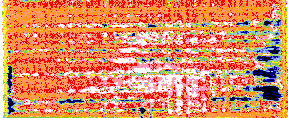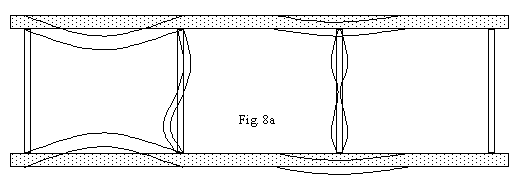WAVE MODES PRODUCED BY AIR COUPLED ULTRASOUND
by Jan O. Strycek, Willem A. Grandia, and Hanspeter Loertscher
Presented on the Application Workshop in May '97
1. Introduction
The use of guided waves for non-destructive testing has become increasingly common over
the past few years, as demonstrated by the UT Articles presented in the March issue of the
UT Online Journal (ref.1), and by the Lamb Wave Bibliography (ref.2) of the same Journal.
One of the aspects that make guided waves attractive for testing is their ability to
propogate along surfaces over distances of tens of centimeters and therefore to allow a
significant increase in scanning speed. Other aspects are the possibility of material
characterization and economical flaw detection in layered media as used in the aerospace
and petrochemical industries.
A prerequisite for the successful application of guided waves in most cases is a
surface which does not damp the surface wave. This precludes the use of liquid couplants,
therefore special dry coupled transducers must be used. Alternatives can be found in laser
generated (ref.3) and air coupled ultrasound. Air coupled ultrasound with transducers
having stand-off distances in the centimeter range, and which are already used by the
industry in the through-transmission configuration (ref. 4), are well suited for guided
wave applications.
2. AIR COUPLED ULTRASONIC SYSTEM
| The impedance mismatch between air and transmitter/receiver and, more
importantly, between air and test part introduces total reflection losses in through
transmission which can exceed 120 dB (for more details see ref.5). Although matching
layers on the transducers can reduce these losses by about 40 dB, more sophisticated
measures must be taken in order to receive a signal with an acceptable signal to noise
ratio.
On the transmitting side, high sound pressures are generated by a resonant transducer
with a focused beam profile (Figure 1). |
 |
The transducer is driven with tonebursts of 400 kHz with 15 cycles at a repetition rate
of 300 Hz (figure2).

The same transducer design is used on the receiving side. The received signal is
pre-amplified (yielding a signal to noise ratio exceeding 40 dB), then further amplified
by a super-low noise amplifier.
Both transducers are 25 mm in diameter and spherically contoured with a focal length of
38 mm, resulting in a focal spot in air of 1.3 mm. The control unit (SONDA 007C) provides
for fine tuning of the transmitter driver and the receiver bandpass to the respective
resonant frequencies.
3. TRANSDUCER CONFIGURATIONS AND WAVE MODES
Air coupled transducers can be aligned in several ways, as shown in Figures 3 and 4.
Figure 3, Bulk Waves: a) Through-transmission compressional
wave. b) Through-transmission shear wave. c) Pseudo pulse-echo
with a sound barrier between transmitter and receiver.
Figure 4, Guided Plate Waves: a) Transducers on same side
(one-sided). b) Transducers on opposite sides (two-sided).
The various configurations are named according to the wave modes that are generated,
analogous to contact transducers. Conclusive evidence for certain modes exists in some
cases, while investigations are in progress for more complex test structures. In all the
cases here presented, flaws could be detected reliably - even if the active wave modes
were not known with certainty.
Applications of the most common configuration (Fig. 3a), which produces
compressional waves in through transmission, are described elsewhere (ref. 4).
4. GUIDED PLATE WAVES - TWO-SIDED
During the process development for solar panels a few years ago, Gr/Ep laminate face
sheets did not comply with their physical specifications after thermocycling. Very fine
microcracks were then detected in the structural analysis. These microcracks could also be
seen through magnifying glasses.
Several nondestructive methods were subsequently evaluated in order to detect these
microcracks. Among the methods that failed to detect those flaws were X- ray holography,
micro focus X-ray, ultrasonic water squirters, shearography, mechanical impedance, and
acoustic impedance.
Detection was possible with the air coupled technique. The guided plate wave
configuration was used with the transducers on opposite sides (Fig. 4b). The
transducers were adjusted to form an angle of 10 degrees to the normal, and the distance
between the focal points on the part was 10 mm.
 |
Fig. 5a shows the C-scan image of an intact Gr/Ep
laminate before thermocycling (dimensions: 150 mm x 150 mm, 0.15 mm thick; step size 0.5
mm, scan speed 76 mm/sec). |
 |
Fig. 5b shows the same sample after thermocycling. Note
the fine horizontal blue lines. Material analysis and visual inspection with magnifying
glasses identified these lines as microcracks. |
5. SHEAR WAVES IN THROUGH TRANSMISSION
Titanium/Graphite laminates were scanned with the transducers in through transmission
configuration for shear waves (Fig. 3b.).The laminates were 1.7 mm thick and
consisted of 13 intermittent layers of titanium and graphite/epoxy. The C-scans were
performed at 130 mm/s, using a step size of 0.76 mm. Figure 6a shows a the results
as homogeneous, regular pattern without any indications of flaws, while the sample shown
in Figure 6b displays many bright lines and dark areas indicative
of flaws. The precise ultrasonic mechanism as well as the significance of the findings is
still under investigation.
 Figure 6a Figure 6a |
 Figure 6b Figure 6b |
6. HONEYCOMBS
A typical C-scan image of a honeycomb with the air-coupled transducers aligned in
through transmission (Fig. 3a) is shown in Figure 7. The cell diameter is 10
mm. The sample was scanned with a step size of 1 mm and at a speed of 150 mm/sec. The cell
walls display high signal transmission (white) and are clearly distinct from the cell core
(black). Unbonds between face sheet and core (not present in Fig. 7) can clearly be
detected with this method (ref. 4).
 Figure 7 Figure 7 |
Considering the thickness d of the composite face sheet (0.15 mm) and
the aluminum core (0.018 mm) raises questions about the transmission mechanism of the
ultrasonic waves. The following table lists sound velocities (CL :
longitudinal, CT: compressional wave) and wavelengths l for the air scan
frequency of 0.4 MHz.
| MATERIAL |
CL [m/s] |
C T [m/s] |
f [MHz] |
 [mm] [mm] |
d [mm] |
| Air |
340 |
na |
0.4 |
0.85 |
38 |
| Composite |
3000 |
1500 |
0.4 |
7.5 |
0.15 |
| Aluminum |
6400 |
3040 |
0.4 |
16 |
0.018 |
The ultrasonic wavelengths of 7.5 mm and 16 mm are orders of magnitudes
larger than the material thicknesses of 0.15 mm and 0.018 mm. Consequently, neither
compressional nor shear waves can be involved. Plate or surface waves must be considered
as possible transmission mechanisms. Figure 8a shows in a sketch how plate waves
(symmetrical and asymmetrical) could be generated directly or by mode conversion. The face
sheet is shown with asymmetrical plate waves, while the aluminum core is shown with both
asymmetrical (left side) and symmetrical (right side) plate waves.
 The dispersion curves, displaying the relation between phase velocity of
the various lamb waves a0, a1, a2, ... and s0,
s1, s2, and the product of thickness d and frequency f are shown in Figure
8 (ref 6). For the aluminum core mentioned in the above table, the product d*f equals
7.2 m/s, which coincides with the ordinate in Figure 8. Only the symmetrical s0 or
the asymmetrical a0 mode is therefore possible in the aluminum core. According to the
above equations the phase velocities are:
The dispersion curves, displaying the relation between phase velocity of
the various lamb waves a0, a1, a2, ... and s0,
s1, s2, and the product of thickness d and frequency f are shown in Figure
8 (ref 6). For the aluminum core mentioned in the above table, the product d*f equals
7.2 m/s, which coincides with the ordinate in Figure 8. Only the symmetrical s0 or
the asymmetrical a0 mode is therefore possible in the aluminum core. According to the
above equations the phase velocities are:
- asymmetrical plate wave: cP = 260 m/s
- symmetrical plate wave: cP = 5300 m/s.
Observations of time of flight indicate a velocity in the range of several thousand
m/s. The asymmetrical plate wave is too slow, therefore the ultrasound is transmitted
through the core by the symmetrical plate wave.
Strong evidence for the involvement of plate waves in the testing of honeycombs by air
coupled techniques was obtained when testing the honeycomb sample, which was manufactured
by using the face sheet with the previously observed microcracks (Figure 5b).
The honeycomb sample was scanned with the transducers in the through transmission
configuration (Fig.3a), and the C-scan image is reproduced in Figure 9. Note
the black horizontal lines. They coincide with the microcracks detected in the face sheet
using plate waves. The fact that the same cracks appear now with the through transmission
configuration is believed to be possible only because of the existence of plate waves.
 Figure 9 Figure 9 |
More precise measurements and additional investigations are needed to fully understand
the variety of modes and mode conversions that are very likely to occur in honeycomb
structures.
7. CONCLUSION
Air-coupled ultrasonic techniques have been shown to produce plate waves, and to
successfully apply to industrial testing. Investigations are in progress to further
exploit the potential of plate and surface waves for economical nondestructive testing
procedures.
8. REFERENCES
- UTonline March issue
- UTonline Lamb Wave Bibliography
- Hutchins and Lundgren: A Laser Study Of Transient Lamb Waves In Thin Materials, J Acoust
Soc Am 85, 1441, 1989.
- Loertscher, Grandia et al.: Airscan Transducers, Technique And Applications. UTonline
09/96
- Grandia and Fortunko: NDE Applications Of Air-Coupled Ultrasonic Transducers. 1995 IEEE
Ultrasonic Symposium, Proceedings, Vol 1, pp. 697-709, ISSN 1051-0117.
- Brekhovskikh: Waves In Layered Media. Academic Press, New York, 1960.
Authors:
Willem A. Grandia, P.E.
The late Bill Grandia was founder and president of QMI, where he directed R&D. He
was a senior electronic and quality engineer, recognized worldwide for his achievements in
designing ultrasonic and Eddy Current instrumentation. He started his career in 1955 in
Holland. |
Jan Strycek
Jan formerly served as Vice-President for Technique Development and Marketing. He
acquired in over 25 years an outstanding record in practical testing of a large variety of
materials and structures.
|
Hanspeter Loertscher
Hanspeter received his Master Degree in Physics in 1972 from the University of
Bern, Switzerland and specialized in laser development and applications, including laser
based ultrasonics, and in ultrasonic testing of composite structures.
|
QMI Inc., Huntington Beach CA, USA. E-mail: sales@qmi-inc.com,
Home Page
The paper was presented on the Application Workshop in May '97









 Figure 6a
Figure 6a Figure 6b
Figure 6b Figure 7
Figure 7
 The dispersion curves, displaying the relation between phase velocity of
the various lamb waves a0, a1, a2, ... and s0,
s1, s2, and the product of thickness d and frequency f are shown in Figure
8 (ref 6). For the aluminum core mentioned in the above table, the product d*f equals
7.2 m/s, which coincides with the ordinate in Figure 8. Only the symmetrical s0 or
the asymmetrical a0 mode is therefore possible in the aluminum core. According to the
above equations the phase velocities are:
The dispersion curves, displaying the relation between phase velocity of
the various lamb waves a0, a1, a2, ... and s0,
s1, s2, and the product of thickness d and frequency f are shown in Figure
8 (ref 6). For the aluminum core mentioned in the above table, the product d*f equals
7.2 m/s, which coincides with the ordinate in Figure 8. Only the symmetrical s0 or
the asymmetrical a0 mode is therefore possible in the aluminum core. According to the
above equations the phase velocities are:  Figure 9
Figure 9